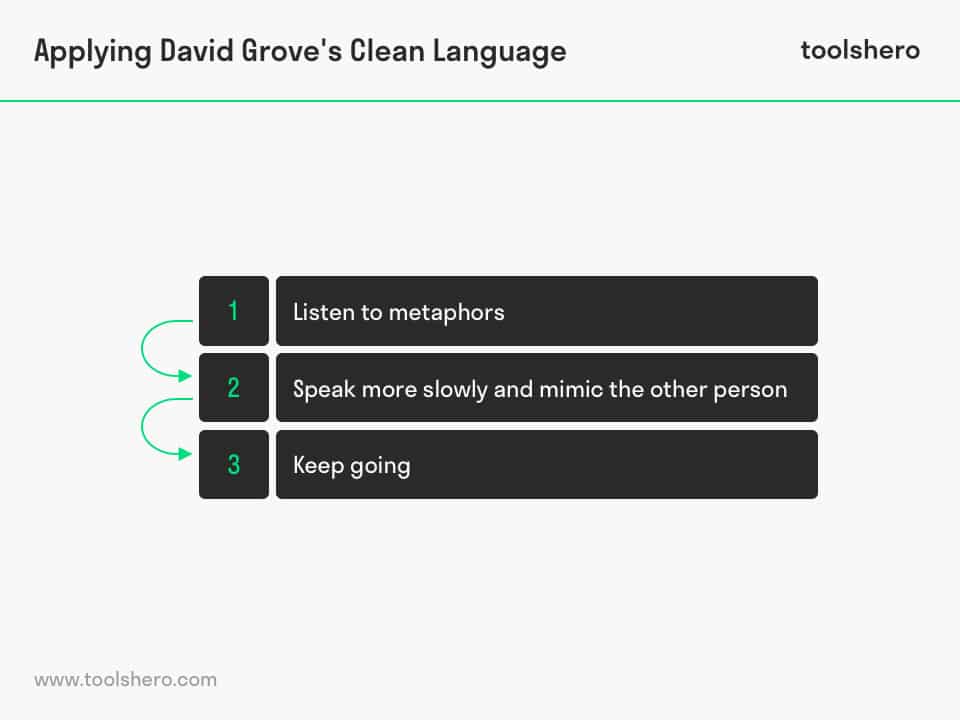David Grove’s Clean Language

David Grove’s Clean Language: this article provides a practical explanation of David Grove’s Clean Language. After reading this article, you’ll have more insight into this Communication Skills method developed by David J Grove (Counselling Psychologist) in the eighties. In this method, the most important goal is to convey a personal opinion without any emotional or distracting interpretation of others.
What is the David Grove’s Clean Language technique?
Psychotherapist David Grove developed the Clean Language technique in the eighties when he realised that many therapists subtly influenced what their clients said during the sessions. He noticed this was particularly true when it concerned the use of metaphors.
Clean Language is a simple and subtle question process that could help to advance clarity and change in an extraordinarily efficient, effective, and highly respectful way that keeps the focus on the goals and personal development of your clients.
That is, you learn to ask questions and listen to others without inserting your own assumptions or interpretation. It forces you to make a practical distinction between what you want and what’s important to you and to the other. The result is that you understand each other better, learn faster, and that desired results are more easily achieved.
Clean Language also forms the basis for Symbolic Modelling, a stand-alone method and process for psychotherapy and coaching, developed by Lawley and Tompkins; Clean Space; and Systemic Modelling, applied in organisation development. It can also be used to supplement the approach of a therapist or coach.
David practised his methods in the context of resolving a complex trauma. An example is the lesson material: Grove, David J: Panzer, Basil I. (1989). The following years, his workshop materials included titles such as: ‘Metaphors to Heal by’, ‘Resolving Traumatic Memories’, ‘Healing the Wounded Child Within’, and ‘In the Presence of the Past’
Clean Language combines four elements of communication: syntax, wording of questions, vocal qualities, and non-verbal behaviour. These elements are described below.
Syntax
In a therapeutic context, Clean Language questions often use the ‘full 3-part syntax’ with the following format:
And [words of the client / non-verbals] … and when/as [words of the client / non-verbals] …?
This structure arises from the former hypnotic works of Grove and was designed to focus attention, minimise the cognitive load, and make it easier for the client to remain in the inner-directed state. Outside the therapeutic context, an ‘everyday’ syntax is usually used.
Wording of questions
By minimising the contents originating from the asker, such as the metaphors, assumptions, paradigms, or sensations. These might distract the questionnee’s attention from an increased level of awareness of his or her (metaphoric) representation of experience.
It offers a template for questions that are as open as possible to the suggestions, assumptions, thoughts, references, and metaphors of the conversation partner.
These questions contain all or part of the specific wording of the client and could also contain other auditive communication components of the client, such as speed, pitch, tonality.
Additionally, oral sounds (such as sighing, oohs and ahs) and other non-verbal signals (a first being raised or a line of sight) are replicated in a question when the conversation partner believes they are symbolic for the client.
Vocal Qualities
Speed, tone, and volume could also affect the kind of attention the client pays to his own experience. Where the client’s words are used, the vocal qualities of the client’s words are repeated. In therapeutic applications, the words of the asker are often given more slowly with a rhythmic and poetic tonality. In daily interactions, the facilitator can stay close to his usual tonality.
Non-verbal Behaviour
Non-verbal behaviour is the way in which someone expresses himself in addition to spoken words. This includes gestures, posture, lines of sight, and other motions of the body. The facilitator minimises his own non-verbal behaviour and does not mimic the motions of the client’s body. Instead, the facilitator uses gestures and lines of sight that are congruent with the location of the imaginative symbols of the client from the client’s perspective.
Why David Grove’s Clean Language?
Although Clean Language originated in psychotherapy, there are many advantages to its use in the workplace.
First, the technique helps to increase the self-awareness of your team members. You reflect their own metaphors. The repetition allows them to discover patterns and associations in their thinking, which helps to develop new insights about themselves.
Clean Language also helps you build a good relationship
with people. When you use their language, they will feel supported, respected, and heard. They will also be motivated to improve their situation.
Getting started with David Grove’s Clean Language
When you use Clean Language, you hold up a mirror to others and reflect their own words, gestures, and voice back to them.
Clean Language Questions
There are nine simple questions about Clean Language that could help you clarify the speaker’s meaning when they use a metaphor:
- And is there anything more about …?
- And what kind of … is that …?
- And where is …?
- And place?
- And what happens after?
- And what happens then?
- And what happens just before …?
- And where could … come from?
- And that is … like what?
The steps below explain how you can apply this communication method during conversations.
Step 1: Listen to metaphors
When you are having a conversation with a team member, listen closely to what he/she says. Your goal is to identify the metaphors he/she uses to define their experiences.
Metaphors are often preceded by the word ‘like/as’. For instance: ‘He is as stubborn as a mule’ or: ‘This department is like a sinking ship.’ Is the person describing something they’re literally doing, or are they talking about what something is like?
Example of a metaphor in a sentence: ‘ “Insert name” must build his self-confidence’. Building is a metaphor: he is not literally building his self-confidence like you would build a house. It’s a metaphor.
Another example of a metaphor is: ‘This place is a pigsty!’ This isn’t really the case, the expression simply means it’s very messy.
It can be difficult to identify metaphors at first, because they are frequently used and we don’t think twice about them. That’s why active listening is so important.
Important: Don’t forget to focus completely on the person you’re speaking with. You don’t have to share your opinion nor give advice. Where possible, use his or her own words in your questions.
Step 2: Speak more slowly and mimic the other person
When the person has finished speaking, you use one of the nine questions about Clean Language to clarify what they said. Out of the nine, the first two are the most popular.
- And is there anything more about …?
- And what kind of … is that …?
Strive to speak twice as slowly as the other person, try to mimic their intonation and body language as much as possible, and speak in a slightly deeper voice. This ensures that your conversation partner can relax and makes it easier for them to explore their thoughts and feelings.
Step 3: Keep going
Your conversation partner most likely has new insights with each Clean Language question you use. Keep asking questions until they have fully explored their feelings and have arrived at a solution about their situation.
To Summarise
Clean Language is a question technique designed by David Grove in the eighties. He has given it a path in a generosity framework. When observing conversations as a psychotherapist, he recognised that the way the question is phrased influenced a patient’s ability to answer. The ability to answer subsequently influenced the patient’s ability to develop solutions and understanding.
When using Clean Language, you do the following:
- (Temporarily) leave your interpretations and assumptions outside the conversation and only guide the other’s attention;
- Are informed through the logic system of the other;
- Find out more about what matters to the other person;
- Make your conversation partner think beyond their conventional paths;
- Make sure that change is initiated from within.
Now It’s Your Turn
What do you think? Are you familiar with the explanation of David Grove’s Clean Language or do you have anything to add? In which scenarios do you think this method will be effective? What do you believe are success factors that contribute to the practical application of this theory?
Share your experience and knowledge in the comments box below.
More information
- Wilson, C. (2017). The Work and Life of David Grove: Clean Language and Emergent Knowledge. Troubador Publishing Ltd.
- Lawley, J. & Tompkins, P. (2000) Metaphors in Mind: Transformation through Symbolic Modelling
- McCracken, J. (2014). Clean language in the classroom. Crown House Publishing.
- Sullivan, W. & Rees, J. (2008) Clean Language: Revealing Metaphors and Opening Minds
How to cite this article:
Sari, J. (2019). David Grove’s Clean Language. Retrieved [insert date] from Toolshero: https://www.toolshero.com/communication-methods/david-groves-clean-language/
Published on: 02/12/2019 | Last update: 05/19/2022
Add a link to this page on your website:
<a href=”https://www.toolshero.com/communication-methods/david-groves-clean-language/”>Toolshero: David Groves Clean Language</a>













